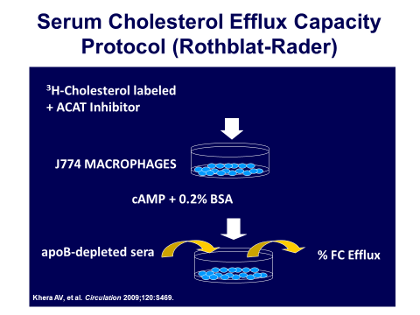Rosenson - Figure 15 - Efflux capacity protocol Text
We know that cholesterol efflux from the macrophages can decrease the inflammatory output from experimental animal models, but how can we study cholesterol efflux from the macrophages that is relevant to human studies?
In work by George Rothblatt and Dan Rader a cholesterol efflux assay has been developed that loads cholesterol into mouse macrophages and then prevents the cholesterol from getting out with an acyl CoA:cholesterol acyltransferase (ACAT) inhibitor. The macrophages are then primed with cyclic AMP, which up-regulates the ABCA1 transporter. Then human blood samples are collected and the HDL particle subfractions are incubated with the cultured murine macrophages. The result is a measure of the ability of the human serum to efflux the cholesterol out of the macrophages.
In an important paper in the New England Journal of Medicine[51] these investigators showed that this measure of HDL “functionality” was more related CVD risk, as assessed by cIMT and carotid stenosis by angiography, than other measures of HDL. So again, when we talk about serum HDL cholesterol levels or HDL particle concentration, these are static measures, when what we really want to know is, how well do these HDL particles function?
J Clin Lipidol. 2011; 5(6).References
[51]Khera AV, Cuchel M, de la Llera-Moya M, el. Cholesterol efflux capacity, high-density lipoprotein function, and atherosclerosis. N Engl J Med. 2011 Jan 13; 364(2):127-35.
